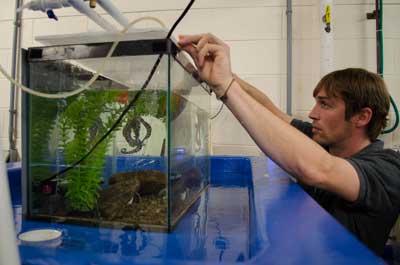Bringing Cephalopod Culture to New Heights at the MBL

Bret Grasse joined the Marine Biological Laboratory (MBL) last spring as Manager of Cephalopod Operations, a new position in the Marine Resources Center. Cephalopods (squid, octopus, cuttlefish, and nautilus) have unique characteristics that make them excellent research subjects in many fields, including neuroscience, physiology, behavioral science, evolutionary development, materials science, and robotics. However, new methods for culturing and analyzing cephalopods are needed in order to deploy them as robust model systems in experimental research. Solving these challenges is a strategic priority for the MBL and for Grasse.
Previously, Grasse was a senior aquarist at Monterey Bay Aquarium, where he managed a large-scale cephalopod operation with over 30 species. Methods he developed led to the first successful culture of the flamboyant cuttlefish and pajama squid, among other advances in cephalopod husbandry. Grasse also launched the first large-scale public exhibition of cephalopods, called “Tentacles.” Below, he discusses his role in the MBL’s ambitious goal to develop cephalopods into genetically tractable and widely used model systems.
What brings you to MBL?
The amazing quest for discovery. The location and the people. And it’s the resources and the vision toward the group of animals that I am so passionate about. We plan to build a “cephalopod empire” at the MBL that encompasses multiple cephalopod species that can be used in different research communities. This summer, we’re trying to highlight several candidate species that are very hardy in the lab that will be good candidates as model systems. We are looking for species that we can bring from egg to adult and adult to egg again – what we call “closing the life cycle.” Cephalopods are short-lived and can be unpredictable; they really keep you on your toes as a biologist in order to provide the best possible care and culture them through multiple generations.
 Manager of Cephalopod Operations Bret Grasse checks on a mimic octopus (Thaumoctopus mimicus) in the MBL's Marine Resources Center. Photo: Jennifer Tsang
Manager of Cephalopod Operations Bret Grasse checks on a mimic octopus (Thaumoctopus mimicus) in the MBL's Marine Resources Center. Photo: Jennifer TsangHow did you get started working with cephalopods?
When I arrived at Monterey Bay Aquarium, their cephalopod eggs had only about a 20 percent survivorship rating. We increased survivorship to 95 percent through strategies such as optimal seawater system arrangement, periodic practices like dipping the eggs in prophylactic baths, and artificial incubation methods. Some cephalopod species will brood their eggs: they push water jets over them to promote oxygenation and keep them free of fouling organisms. We set up systems to do that for the females, so they can reallocate their energy into producing more eggs. One incubation method I developed used soda bottles to provide uniform water circulation and gentler flow to the eggs. We’ve needed to develop creative designs over the years to maximize hatching survivorship and success.
Are you keeping cephalopods in local seawater in the Marine Resources Center (MRC)?
Everything in the MRC was set up to support native species and now we have all these non-natives, such as octopuses. So we are rethinking some of the systems that were used for hardy marine fish, such as teleosts, and marine invertebrates. Very sensitive organisms like cephalopods need optimal water quality so we are re-designing to provide that.
Why are cephalopods promising as model systems for research?
Cephalopods have many unique and exaggerated characteristics of interest to study. Their neurons are very large, which is useful to neurobiologists. They have the biggest brain-to-body ratio of any known animals. They can regenerate arms and other tissues very quickly. Physiologically, they are supremely weird. Octopuses have three hearts, blue blood, and neurological receptors at the base of each arm, so it’s like they have eight brains in addition to a central brain. We culture cephalopods through successive generations for the MBL Embryology course students to study their development. Cephalopods also have interesting, complex behaviors, such as unmatched ability to change the color and texture of their skin for camouflage. Carrie Albertin, who is a Hibbitt Fellow at MBL, published the first cephalopod genome a few years ago and discovered it is really dissimilar to other animal genomes; it’s way out there. They are like aliens on earth. The more we can figure out about these exaggerated characteristics, the more we can draw on them for applications for humans.
What might some applications be?
Many have been suggested. For instance, people who study soft robotics are interested in octopuses, because they can squeeze through small holes and then reassemble themselves on the other side. For surgery, you could make the tiniest nick in the body and have this soft robot go in, reassemble itself, do the surgery and come back out. That could be very powerful. Furthermore, there may be biomedical applications. We could better understand and possibly address human health problems by learning from the biological processes of cephalopods. Cephalopods could also be a great food source because they’re high protein and low fat, and grow rapidly. They could take over the aquaculture industry if the wild population of food fish were to plummet.
Can you describe something strange or funny that you have encountered while working with cephalopods?
One funny thing involved a group of cuttlefish. When you went up to the tank they would come to the surface, which is not uncommon because they usually associate humans with food. While you watched them, they just sat there and watched you. But as soon as you turned your back, they’d squirt water at you!
Interview edited and condensed by Jennifer Tsang and Diana Kenney
